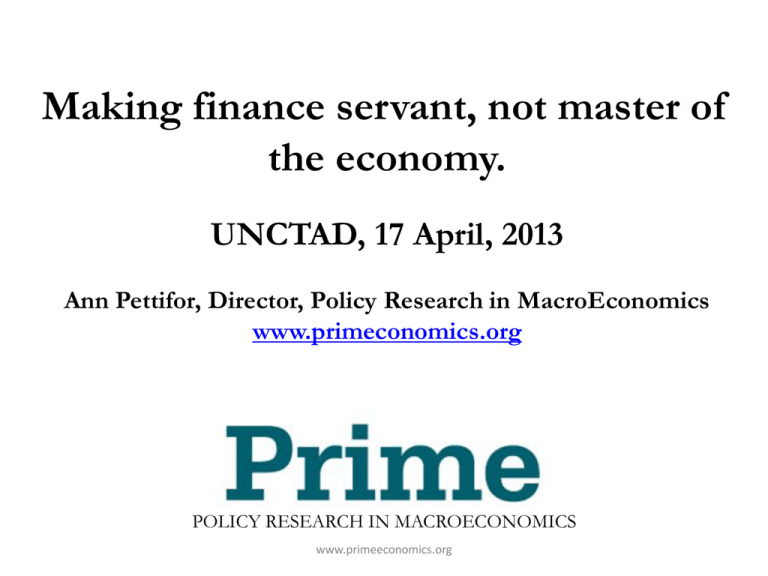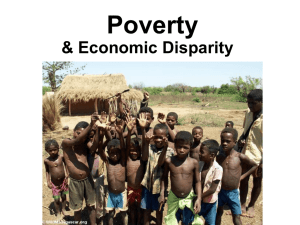Making finance servant, not master of the economy. UNCTAD, 17 April, 2013
advertisement

Making finance servant, not master of the economy. UNCTAD, 17 April, 2013 Ann Pettifor, Director, Policy Research in MacroEconomics www.primeconomics.org Edinburgh. POLICY RESEARCH IN MACROECONOMICS www.primeeconomics.org Ann Pettifor PRIME Just Banking Conference, 20 April, 2012 Steve Keen, Beware governments' post-doping malaise. Business Spectator, 4 February, 2013. http://www.businessspectator.com.au/bs.nsf/Article/UK-GDP-growthmarkets-recession-debt-pd20130204-4KMTS Budget Report 2011: Rebalancing the UK economy 1.1 Over the pre-crisis decade, developments in the UK unsustainable levels of private sector debt and rising public sector economy were driven by debt. Indeed, it has been estimated that the UK became the most indebted country in the world. Budget Report 2011 (cont) 1.2 Chart 1.1 highlights the rise in private sector debt in the UK. Households took on rising levels of mortgage debt to buy increasingly expensive housing, while by 2008 the debt of nonfinancial companies reached 110 per cent of GDP. Budget Report 2011 (cont) Within the financial sector, the accumulation of debt was even greater. By 2007, the UK financial system had become the most highly leveraged of any major economy. The level of public sector net debt as a share of GDP steadily rose from 2001-02, as the government ran a persistent structural deficit, despite continued economic growth. McKinsey Global Institute: Debt and De-leveraging the global credit bubble and its consequences. Jan 2010. Budget Report 2012: A Stable Economy. 1.1 The financial crisis of 2008 and 2009 exposed an unstable and unbalanced model of economic growth in the UK based on ever-increasing levels of public and private sector debt. As a result of that crisis, and unsustainable levels of public spending, the Government inherited the largest deficit since the Second World War and the UK economy experienced the biggest recession of any major economy apart from Japan. The time for deception, delusion and evasion is over. It is time for plain speaking. 1. The primary cause of the continuing financial crisis is the unprecedented inflation – and then deflation - of a vast expanse of de-regulated, liberalised private credit created by banks and financial entities. Easy, deregulated,but dear credit financed and blew up asset bubbles across all economies. Who Benefited? iberalisation/globalisation? Chart taken from a speech, on the 8 May, 2009 by Andy Haldane, Executive Director, Financial Stability, Bank of England. 2. The eventual puncturing of this vast bubble of credit – by high real rates of interest (%) 8 Australia 7 UK 6 5 4 EU 3 US 2 Japan 1 0 2003 2004 2005 2006 2007 2008 2009 2010 2011 2012 Sources: BOJ, FRB, ECB, BOE and RMB Australia. As of Mar. 23, 2012. Chart taken from presentation by Richard Koo, Chief Economist, Nomura Research Institute, Tokyo, to the INET Conference, Berlin, 14th April, 2012. Debt that is now slowly, but chaotically being de-leveraged (or not) blocked by: - denial - forbearance - ‘hands-off’ - ‘market clearing’ - political sclerosis The de-leveraging process is slow: • Firms are already indebted, and so are hoarding cash, and withholding investment fearful that austerity means customers will not walk through their doors • Austerity is contracting income – for indebted public employees, firms, households and the unemployed • Government is taking a ‘hands off’ ‘leave it to the market’ ‘nothing to do with us Guv’ approach. There is a way through to recovery. We have the economic tools - they are known & understood They have been used before, and proven extremely effective. They were used by Roosevelt’s 1933 Administration – and led to the US recovery pre-war • They were subsequently used by the British Conservative government – after being turned down by Ramsay McDonald’s Labour and later, Coalition government. • Above all, they were used during the Golden Age: 1945 – 71 to ensure financial stability; high rates of employment and a sense of well-being. Capital Mobility and the Incidence of Banking Crisis: All Countries, 1800-2007: Chart taken from “This Time is Different: A Panoramic View of Eight Centuries of Financial Crises” by Carmen M. Reinhart, University of Maryland and NBER; and Kenneth S. Rogoff, Harvard University and NBER. CTBI 20th Jan 2009 John Maynard Keynes gave us the tools with which to stabilise a chaotic, out of control financial system. JMK devised these policies as a result of his direct experience of post First World War ‘austerity’ – and of the collapse of the vast credit bubble of the 1920s 1929. The five economic tools we have to fix the economy – and address climate change are: the creation of finance/money by the BoE - ‘out of 1. QE – thin air’ – and aimed at sound govt investment – not speculation. 2. The spending of this money via government investment in sound infrastructure – Green – projects “The important thing for government is not to do things which individuals are doing already, and to do them a little better or a little worse, but to do those things which at present are not done at all.” J.M. Keynes: “End of Laissez-Faire” p. 291 in “Essays in Persuasion” Volume IX of Collected Works, MacMillan, 1972. 3. The regulation of credit creation by the banks - directed at productive investment not speculation. 4. Permanently low rates of interest across the spectrum – short & long, real, safe & risky - to ensure debts are affordable, and ecologically sustainable; and to encourage new, private investment . Capital control – 5 to facilitate permanently low rates – and limit speculation. Managed finance as opposed to liberalised, globalised finance 180 (Aug. 2008 =100, Seasonally Adjusted) 170 Base Money Money Supply (M3) 160 Credit to Euro Area Residents 150 140 130 120 110 100 90 2.2 2.0 1.8 1.6 1.4 1.2 1.0 0.8 0.6 (%, yoy) CPI core 08/1 08/4 08/7 08/10 09/1 09/4 09/7 09/10 10/1 10/4 10/7 10/10 11/1 11/4 11/7 11/10 Sources: ECB, Eurostat Note: Base money's figures are seasonally adjusted by Nomura Research Institute. Presentation by Richard Koo, Chief Economist, Nomura Research Institute, Tokyo, to the INET Conference, Berlin, 14th April, 2012. 12/1 The Six Steps - to economic recovery The Six Steps - to economic recovery 1. Introduction of capital controls 2. Large scale reform of the banking system, including regulation of credit creation 3. Large scale reform of debt management policy 4. Government expenditure – investment in the Green New Deal 5.Creation of fossil-fuelsubstituting jobs – in public & private sectors “Look after unemployment, and the budget will look after itself.” JMK 6. Generation of income – • Wages & salaries • Profits for SMEs and other firms • Tax revenues for government- Result? 6. Recovery “What we can create, we can afford.” JM Keynes “National Self-Sufficiency” The Yale Review, Vol 22, no4 (June 1933), pp.755-769 Thank You POLICY RESEARCH IN MACROECONOMICS. . www.primeeconomics.org








